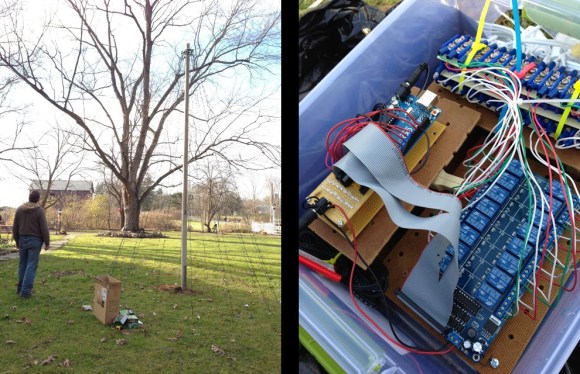
[Jason] and his father took advantage of a week off of work over Thanksgiving to design and build a Christmas light decoration that can flash fancy patterns. He calls it the Uno Christmas Tree. It’s sixteen strands of lights draped between a pole and the ground to form the shape of a tree. The main controller is an Arduino UNO, but what really makes this work is a mechanical relay board with sixteen channels.
Using trigonometry they figured out that the decoration would be fifteen feet tall and have a five-foot radius at the base. A pipe was installed to act as the trunk, with an old toilet flange at the top and stakes at the bottom to anchor the lights. They all make their connections at the controller box using extension cords that were labelled with channel numbers. You can see the final product in the video after the break. But you’ll also want to watch the clip on [Jason’s] blog which shares the sonic symphony created when the mechanical relays really start working.
















Cool idea. Now double the light strands and relays!
I’m working on something similar, but decided to use MOC3010’s to control each individual string. This of course would be inadequate if the combined wattage were to large, but a single strand of 100 mini lights doesn’t draw enough to be a concern. The use of MOC3010 Optotriacs makes the part count and cost much lower.
Also by going down the semiconductor path you also do not have to worry about stuck relays over time. Relays have a limited cycle count before they start failing in various weird ways. Would recommend triacs or SSR (easier to wire) over relays for any project where your going to have them cycling frequently under power.
In my experience with a similar setup the relays probably won’t last a month. But it’s fun while it lasts.
One thing of note based on the pics on his blog… the GFCI should be at the outlet not at the end of the extension cord. The way he has it now, there is the possibility of some sor of ground fault in the first extension cord that would not trip the GFCI.
Thats a really cool tree! what i was thinking was that you could crack open one of the blinking lights and take over their controller it could be a little more dangerous/complicated but would save you money on relay boards and SSR’s and you could make it change color :)
Much cleaner than my first attempt at light control.
http://pachristmas.com/2008-2
When I saw the lead photo I thought if he used a support wire he has half a HF discone antenna. Another commenter mention the possible failure rate of relays, but here(where I live) these strings may not last last a day before they fail. Just too windy too often. I like the simple tree, as is often the case others would have to modify its construction. On relays I inherited the sysop position of a an amateur radio packet radio node. The rig was an Azden that used mechanical T/R relay. AFAIK that relay wasn’t ever replaced in a decade of operation. Admitting it was only switching 50 watts of power but it switched it lot of times in an hour
Good start. Here is the display to emulate:
http://www.youtube.com/watch?v=vX13aBKV368
Hah, this is great work, love it.
Cool. Something I’ve done in the past is take the 150 light string sequencers, cut off the lights, and mate them to 50 light strings to get the same effects. I pair the controller up to a quad box with one outlet being non-functional.
I’ve used them on my christmas tree for years now to get some awesome chase sequences. I intend to mate some of the remaining units to an SCR for higher wattage uses.
Haven’t run a scope on the output, so I don’t know what the slow fade function will do though.